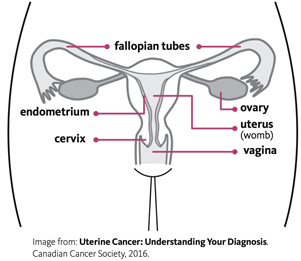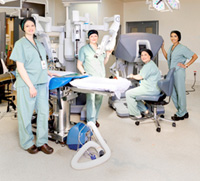Treatment of Endometrial Atypia and Malignancy (TEAM) Clinic

The Treatment of Endometrial Atypia and Malignancy (TEAM) Clinic at St. Michael’s Hospital is a national leader in the use of state-of-the-art robotic surgery techniques to care for patients with endometrial hyperplasia or low-grade endometrial cancer and concurrent obesity.
Our skilled surgeons have advanced training and years of expertise in gynecologic robotic surgery which enables us to provide minimally invasive surgical options for treatment. With this cutting-edge technology, we can successfully manage endometrial hyperplasia and endometrial cancer while reducing the physical burden experienced by our patients.
Our collaborative, multidisciplinary approach to both medical and surgical care allows us to ensure the best possible outcomes. This clinic is affiliated with the University of Toronto and is proud to provide training opportunities for clinical fellows, residents and medical students in addition to supporting ground-breaking clinical research and innovative quality improvement initiatives.
What to expect in your pre-operative appointment
What to expect on the day of your robotic surgery and in post-operative recovery
Mission
Our mission is to advance patient care for those in Ontario with obesity and endometrial hyperplasia and malignancy through patient-centred care, education, and research.
Treatment of Endometrial Atypia and Malignancy (TEAM) Clinic at St. Michael's Hospital
 Dr. Alysha Nensi is the Medical Director of the Treatment of Endometrial Atypia and Malignancy (TEAM) Clinic at St. Michael’s Hospital. She received her medical degree from Western University and completed her residency training in Obstetrics and Gynecology at the McMaster University. She completed a fellowship in Minimally Invasive Gynecologic Surgery at St. Michael’s Hospital and a Master of Science in Healthcare Quality at Queen’s University.
Dr. Alysha Nensi is the Medical Director of the Treatment of Endometrial Atypia and Malignancy (TEAM) Clinic at St. Michael’s Hospital. She received her medical degree from Western University and completed her residency training in Obstetrics and Gynecology at the McMaster University. She completed a fellowship in Minimally Invasive Gynecologic Surgery at St. Michael’s Hospital and a Master of Science in Healthcare Quality at Queen’s University.
Dr. Nensi is an Assistant Professor in the University of Toronto Department of Obstetrics and Gynecology. Her research interests include quality improvement and patient safety in gynecology, peri-operative optimization and Enhanced Recovery After Surgery (ERAS). Her clinical interests include minimally invasive surgery, complex hysteroscopy, colposcopy and vulvar disorders.
 Dr. Andrea Simpson is an obstetrician and minimally invasive gynaecologic surgeon at St. Michael’s Hospital. She is an assistant professor at the University of Toronto and completed an MSc in Health Services Research at the Institute for Health Policy, Management and Evaluation. She is an Adjunct Scientist at ICES.
Dr. Andrea Simpson is an obstetrician and minimally invasive gynaecologic surgeon at St. Michael’s Hospital. She is an assistant professor at the University of Toronto and completed an MSc in Health Services Research at the Institute for Health Policy, Management and Evaluation. She is an Adjunct Scientist at ICES.
Her research interests include access to health services, improving clinical care pathways, early endometrial cancer/endometrial hyperplasia and obesity, as well as issues pertaining to physician health and wellness.
 Dr. Deborah Robertson completed medical school and residency in Obstetrics and Gynecology at McGill University. After residency, she completed a two-year fellowship in minimally invasive gynecological surgery at the University of Toronto.
Dr. Deborah Robertson completed medical school and residency in Obstetrics and Gynecology at McGill University. After residency, she completed a two-year fellowship in minimally invasive gynecological surgery at the University of Toronto.
Dr. Robertson specializes in minimally invasive gynecology, robotic surgery, obstetrics, colposcopy and vulvar health. She is the Program Director of the fellowship in Minimally Invasive Gynecologic Surgery at St. Michael’s Hospital.
 Dr. Sari Kives completed medical school at the University of Toronto and her residency in Obstetrics and Gynecology at the University of British Columbia. Following her residency, she completed three 1-year fellowships in family planning, pediatric gynecology and advanced minimally invasive surgery at the University of Louisville and Queen’s University in Kingston.
Dr. Sari Kives completed medical school at the University of Toronto and her residency in Obstetrics and Gynecology at the University of British Columbia. Following her residency, she completed three 1-year fellowships in family planning, pediatric gynecology and advanced minimally invasive surgery at the University of Louisville and Queen’s University in Kingston.
Dr. Kives specializes in low-risk obstetrics, minimally invasive gynecology, robotic surgery and pediatric/adolescent gynecology. In addition to this, she is also a member of the Minimally Invasive Gynecologic Surgery (MIGS) Team and currently holds the Chair in Women’s Health.
What is endometrial cancer?
Endometrial cancer is cancer that starts in the lining inside the uterus (womb). It is also called uterine cancer or endometrial carcinoma. It is the most common cancer of the female reproductive system.

The image above shows the female reproductive system. The lower part of the uterus is called the cervix. The lining inside the uterus is called the endometrium.
What is endometrial hyperplasia?
Endometrial hyperplasia is when the lining of the uterus (endometrium) becomes thicker than normal. Endometrial hyperplasia is not cancer. However, it can lead to uterine cancer in some people.
What can I expect at my clinic visit?
You will meet with one of our surgeons and clinical fellows. We will:
- Review your past medical history and the results of any imaging tests or biopsies
- Do a physical exam, including an internal exam
- We may repeat an endometrial biopsy if you have not had one recently or if there has been a change in your symptoms
- Discuss treatment options
If you decide to have surgery, it will be booked as soon as possible with one of the four surgeons at the TEAM clinic:
- Dr. Sari Kives
- Dr. Deborah Robertson
- Dr. Alysha Nensi
- Dr. Andrea Simpson
What options do I have for treatment?
Surgery
The standard treatment for atypical hyperplasia or low-grade endometrial cancer is a surgery to remove your uterus, cervix, fallopian tubes and ovaries. Some patients can have minimally invasive surgery. This is “keyhole surgery” using small incisions, done with the Da Vinci™ robot or laparoscopy. Other patients may need open surgery.
Medicine
Taking progesterone is a treatment option for people who cannot have surgery because of medical conditions or surgical risks. This can be a short-term or long-term treatment.
How do I prepare for surgery?
Before your surgery, we may ask you to take a medicine that contains progesterone. This may be in the form of pills, or a device inserted into your uterus. This medicine helps to:
- Decrease any vaginal bleeding
- Prevent the hyperplasia or cancer from progressing
About one week before your surgery, you will have an appointment at the Pre-anesthesia Assessment and Testing Centre (PATC). At this visit, you will see a nurse, an anesthesiologist and a doctor specializing in internal medicine. You may also need to have tests, such as ECG, blood work or x-rays.
What happens after surgery?
Most patients stay in hospital for 1 night after surgery if they had robotic or laparoscopic surgery. If you had open surgery, you will likely stay for two nights.
We recommend that patients who live outside of Toronto book a hotel close to the hospital and stay in the city for one week after their surgery.
Before you leave the hospital, we will give you a prescription for medicine to prevent blood clots. You will need to use this every day for four weeks after your surgery. Our nursing team will teach you how to do this. If you do not have drug coverage, our team can help you with drug access.
You will have a follow-up appointment six weeks after your surgery. We will review test results and make a plan for ongoing follow-up if necessary.
Other resources
- What to expect after your hysterectomy
- Options for post-operative anticoagulation – (Link anticoagulation handout)
- Canadian Cancer Society – What is uterine cancer?
- High Metabolic Clinic
- TVASurg Patient Portal – Robotic hysterectomy
- Robotic hysterectomy for high BMI patients
 Surgical team offers unique treatment for gynecological disease
Surgical team offers unique treatment for gynecological disease
Grace Vosilla had never had a surgery in her life. After cancer cells were discovered in the lining of her uterus, she was referred to St. Michael’s Hospital and told she had grade 1 endometrial cancer. She would need a hysterectomy – a surgery to remove her uterus.
Training the surgeons of the future: developing a robot-assisted surgery curriculum for residents and fellows
Women and robot assisted surgery
Research and publications
Endometrial cancer.
Sobel M, Simpson AN, Ferguson SE.
CMAJ. 2021 Sep 13;193(36):E1423. doi: 10.1503/cmaj.202731.
Robotic-Assisted Laparoscopic Hysterectomy for Endometrial Hyperplasia or Grade 1 Endometrial Adenocarcinoma: A 10-year, Single-Centre Experience.
McLeod LJ, Nensi A, Robertson D, Kives S.
J Obstet Gynaecol Can. 2021 May;43(5):557-563. doi: 10.1016/j.jogc.2020.10.016. Epub 2020 Nov 28.
Highlighting obesity as a risk factor for endometrial cancer.
Simpson AN, Lennox G.
CMAJ. 2021 Jan 11;193(2):E58. doi: 10.1503/cmaj.77367.
Class III Obesity and Other Factors Associated with Longer Wait Times for Endometrial Cancer Surgery: A Population-Based Study.
Simpson AN, Sutradhar R, Ferguson SE, Robertson D, Cheng SY, Baxter NN.
J Obstet Gynaecol Can. 2020 Sep;42(9):1093-1102.e3. doi: 10.1016/j.jogc.2020.03.006. Epub 2020 Mar 27.
Utilizing Lean Methodology to Optimize Operating Room Efficiency: A Multidisciplinary Process Mapping Exercise.
Nensi A, Simpson A, Kives S, Lei R, D’Souza J, Robertson D.
Am J Med Qual. 2020 Jan/Feb;35(1):91. doi: 10.1177/1062860619889884. Epub 2019 Dec 1.
Barriers to care for women with low-grade endometrial cancer and morbid obesity: a qualitative study.
Cusimano MC, Simpson AN, Han A, Hayeems R, Bernardini MQ, Robertson D, Kives SL, Satkunaratnam A, Baxter NN, Ferguson SE.
BMJ Open. 2019 Jun 27;9(6):e026872. doi: 10.1136/bmjopen-2018-026872.
Laparoscopic and robotic hysterectomy in endometrial cancer patients with obesity: a systematic review and meta-analysis of conversions and complications.
Cusimano MC, Simpson AN, Dossa F, Liani V, Kaur Y, Acuna SA, Robertson D, Satkunaratnam A, Bernardini MQ, Ferguson SE, Baxter NN.
Am J Obstet Gynecol. 2019 Nov;221(5):410-428.e19. doi: 10.1016/j.ajog.2019.05.004. Epub 2019 May 10.
The Department of Obstetrics and Gynecology at St. Michael’s Hospital offers a two-year Fellowship in Minimally Invasive Gynecologic Surgery and Pelvic Floor Reconstruction. This world-renowned fellowship program offers surgical training in a wide variety of techniques including laparoscopic, vaginal, and robotic surgery.
TEAM Clinic Referral Form for physicians
Location
Gynecology Clinic Visits
Gynecology Clinics are located in the St. Michael’s Health Centre at 61 Queen St. East, 5th floor. The St. Michael’s Health Centre is located on the south side of Queen St. E, across the street from the main hospital.
Surgical Services
Surgical services are located in St. Michael’s Hospital on the 5th floor of the Cardinal Carter wing, best accessed by the Cardinal Carter north elevators.
Patients admitted to the hospital are located on the 15th floor of the Cardinal Carter wing, best accessed by the Cardinal Carter north elevators.

Last updated October 21, 2025
